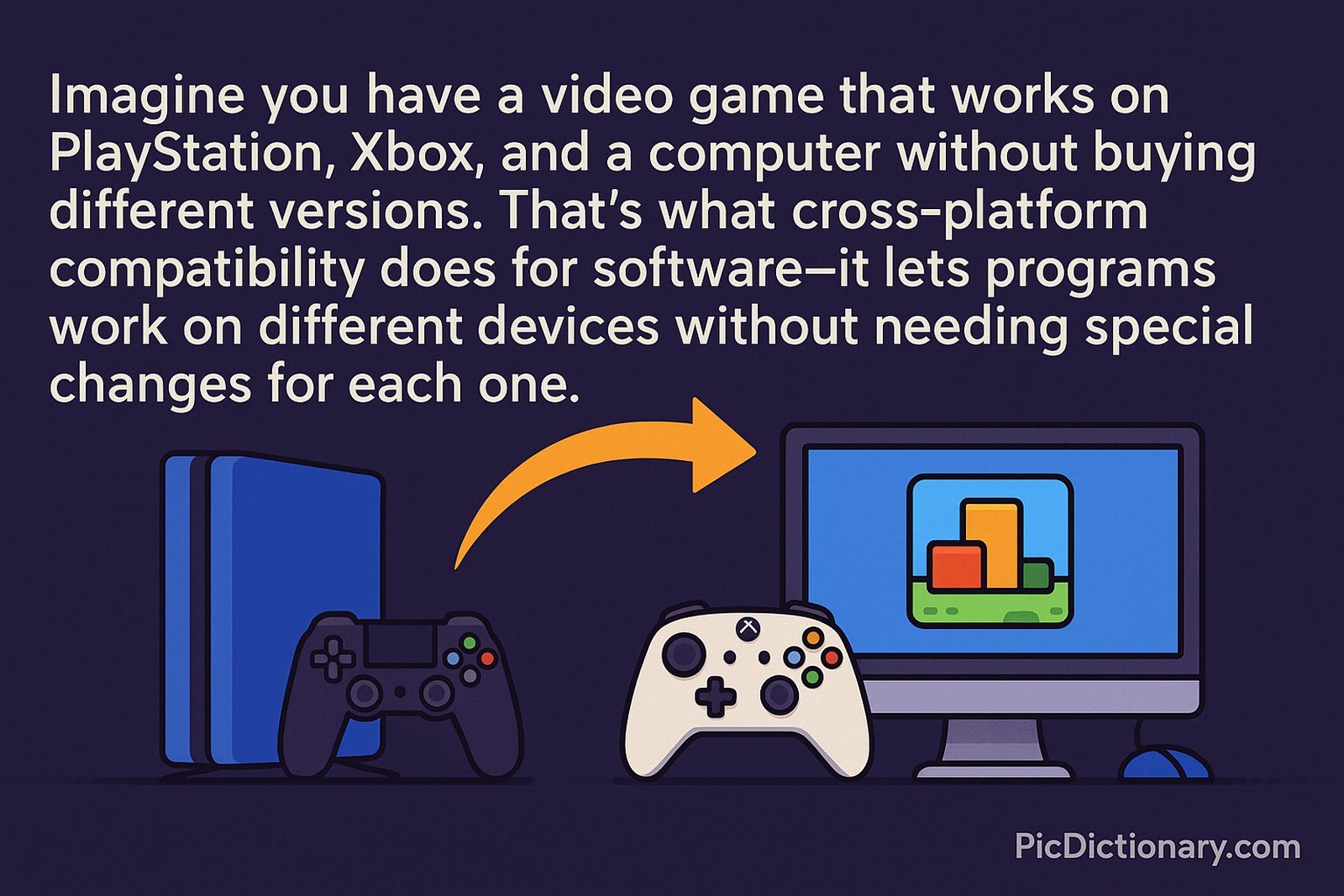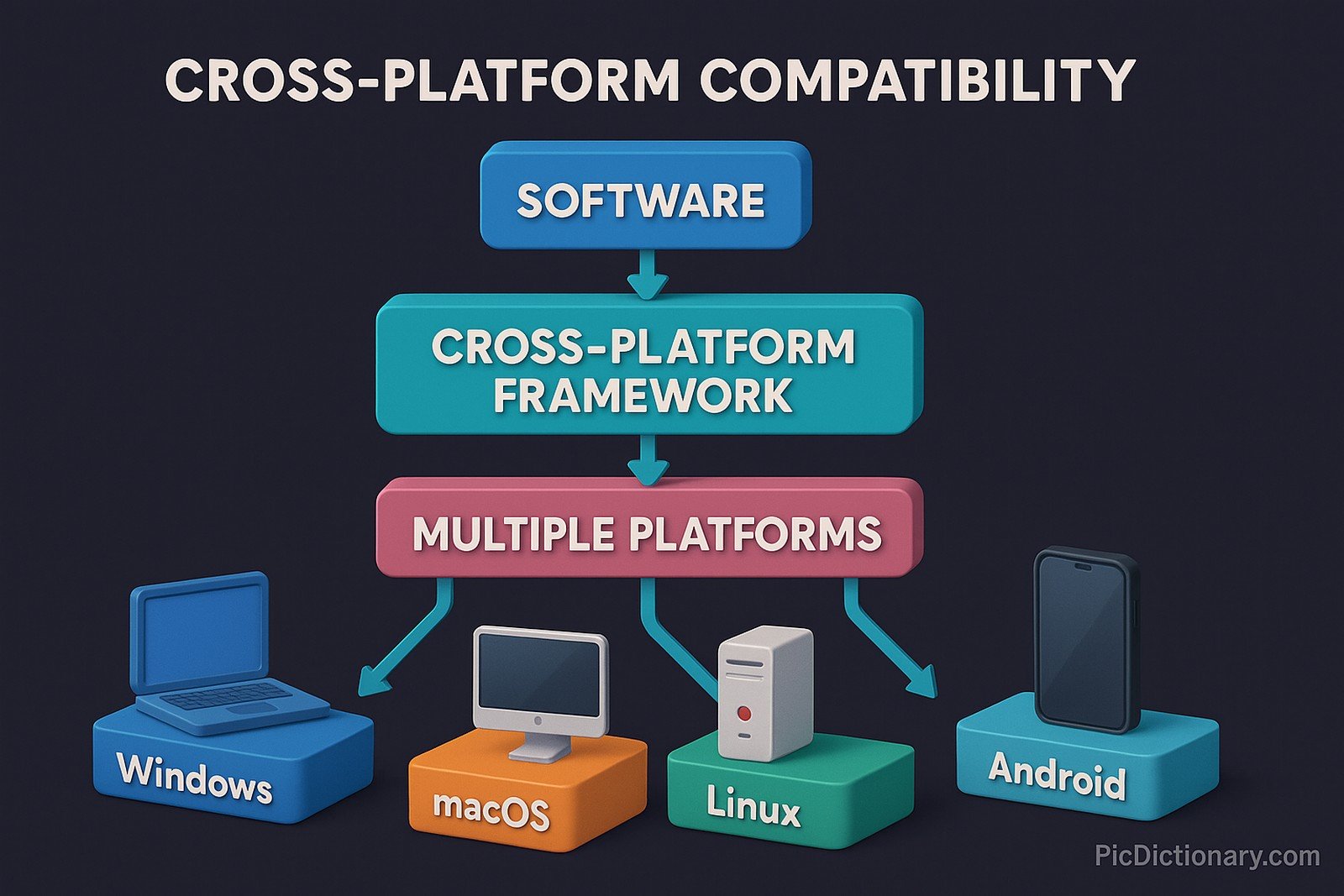Cross-Platform Compatibility

(Representational Image | Source: Dall-E)
Quick Navigation:
- Cross-Platform Compatibility Definition
- Cross-Platform Compatibility Explained Easy
- Cross-Platform Compatibility Origin
- Cross-Platform Compatibility Etymology
- Cross-Platform Compatibility Usage Trends
- Cross-Platform Compatibility Usage
- Cross-Platform Compatibility Examples in Context
- Cross-Platform Compatibility FAQ
- Cross-Platform Compatibility Related Words
Cross-Platform Compatibility Definition
Cross-platform compatibility refers to the ability of software, applications, or systems to function across multiple operating systems or environments without requiring significant modifications. It ensures that a program can run on Windows, macOS, Linux, and mobile platforms like Android and iOS while maintaining consistent functionality and user experience. Developers achieve cross-platform compatibility through frameworks like Electron, Flutter, or web-based solutions such as Progressive Web Apps (PWAs).
Cross-Platform Compatibility Explained Easy
Imagine you have a video game that works on PlayStation, Xbox, and a computer without buying different versions. That’s what cross-platform compatibility does for software—it lets programs work on different devices without needing special changes for each one.
Cross-Platform Compatibility Origin
The idea of cross-platform software emerged as early as the 1980s when businesses needed programs to run on different computer systems. As operating systems diversified, developers started using abstraction layers and runtime environments to ensure compatibility across platforms.
Cross-Platform Compatibility Etymology
The term “cross-platform” originates from "cross," meaning "spanning across," and "platform," referring to a computing environment or operating system. Together, they signify software that can operate on multiple systems.
Cross-Platform Compatibility Usage Trends
With the rise of mobile computing and cloud applications, cross-platform compatibility has become essential. Developers prioritize it to reach a wider audience, reduce development costs, and enhance software longevity. Technologies like containerization (Docker) and cloud-based computing have further advanced this capability, making it easier to deploy applications across different environments.
Cross-Platform Compatibility Usage
- Formal/Technical Tagging:
- Software Development
- Application Portability
- Multi-Platform Support - Typical Collocations:
- "cross-platform application"
- "multi-platform software development"
- "cross-platform framework"
- "universal compatibility"
Cross-Platform Compatibility Examples in Context
- Google Chrome runs seamlessly on Windows, macOS, Linux, Android, and iOS with the same features.
- Many video games now support cross-platform play, allowing users on different consoles to play together.
- Microsoft Office applications are available on multiple platforms, ensuring consistent user experience across devices.
Cross-Platform Compatibility FAQ
- What is cross-platform compatibility?
Cross-platform compatibility refers to the ability of software to operate on multiple operating systems without requiring major modifications. - Why is cross-platform compatibility important?
It allows developers to reach a broader audience, reduces software maintenance costs, and enhances user accessibility. - What are some examples of cross-platform software?
Popular examples include Google Chrome, VLC Media Player, and Microsoft Office. - How is cross-platform compatibility achieved?
Developers use frameworks like Flutter, React Native, or Java Virtual Machine (JVM) to build software that runs on different platforms. - Does cross-platform compatibility affect performance?
In some cases, cross-platform software may have slight performance trade-offs compared to native applications, but optimizations help minimize these. - What challenges arise with cross-platform development?
Differences in system architecture, user interface inconsistencies, and performance optimization are common challenges. - Is web-based software considered cross-platform?
Yes, web applications accessed through browsers are inherently cross-platform as they work across different operating systems. - What’s the difference between cross-platform and native software?
Cross-platform software runs on multiple OSs, while native software is specifically designed for a single OS for better optimization. - Can mobile apps be cross-platform?
Yes, frameworks like Flutter and React Native enable developers to create mobile apps that run on both Android and iOS. - How does cloud computing improve cross-platform compatibility?
Cloud applications run on remote servers, allowing users to access them from any device with an internet connection.

Cross-Platform Compatibility Related Words
- Categories/Topics:
- Software Development
- Operating Systems
- Cloud Computing
Did you know?
One of the first widely used cross-platform applications was Java, introduced in the 1990s with its “Write Once, Run Anywhere” capability. Java programs could be executed on any device with a Java Virtual Machine (JVM), setting the foundation for modern cross-platform software development.
PicDictionary.com is an online dictionary in pictures. If you have questions or suggestions, please reach out to us on WhatsApp or Twitter.Authors | Arjun Vishnu | @ArjunAndVishnu

I am Vishnu. I like AI, Linux, Single Board Computers, and Cloud Computing. I create the web & video content, and I also write for popular websites.
My younger brother, Arjun handles image & video editing. Together, we run a YouTube Channel that's focused on reviewing gadgets and explaining technology.



Comments powered by CComment